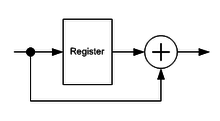Differential coding
The differential encoding is in the digital data transmission , a line coding which in some digital modulation method allows an unambiguous assignment information. It represents a form of simple recursive convolutional coding in which information bits that are adjacent in time depend on one another. It is used, among other things, in digital modulations such as phase shift keying (PSK) or quadrature amplitude modulation (QAM).
motivation
With digital modulations such as binary phase shift keying (BPSK), the receiver cannot recognize which phase position of the carrier wave has which logical value without additional measures , since the receiver does not have the phase information of the transmitter. One possible measure consists in the form of an additional synchronization, which is necessary prior to the actual data transmission, within the framework of which the receiver can determine the phase position of the transmitter and, based on this information, the information contained in the phase position can subsequently be correctly obtained. Another possibility is the differential coding data to be transmitted which in the case of binary phase to the differential phase shift keying, the abbreviated DPSK ( English Differential Phase-Shift Keying leads).
In the case of differential coding, it is not the absolute phase position that matters, but the fact whether or not the phase position at the sampling time has changed in relation to the previous sampling time. As a result, in the simplest case of binary phase shift keying, two states can be formed in the difference between adjacent transmission symbols. The encoder forms the output sequence from the input data sequence according to the following rule:
which is then phase modulated and transmitted to the receiver. After demodulation, the decoder creates the original data sequence from the received sequence according to the following rule:
In the equations stands for the XOR operation or modulo-2 addition. The expression expresses the fact that the state of the previous value is necessary for coding and decoding. In terms of circuitry, this is implemented in the form of a register with a memory depth of one bit, as shown in the adjacent figures. The difference coding thus represents a simple recursive convolutional coding with the memory of one bit.
The differential coding can also be used in various adaptations as a line code without modulation , as is the case, for example, with Non Return to Zero (NRZI) or the differential Manchester code . The difference coding has the advantage that inversion or polarity reversal of the transmission line has no influence.
Due to the memory function of the convolution, the difference coding has the disadvantage that transmission errors can lead to an increase in errors. In binary phase shift keying, for example, a reception error can lead to two chronologically consecutive and incorrect values after the differential coding. This fact can lead to poorer error correction performance in a subsequent forward error correction.
literature
- John G. Proakis, Masoud Salehi: Digital Communications . 5th edition. McGraw Hill, 2008, ISBN 978-0-07-126378-8 , Chapter 3.3: Signaling Schemes with Memory.







